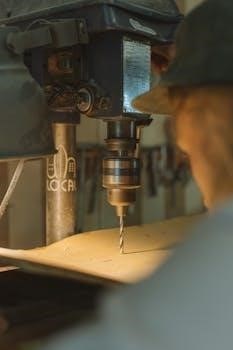Safety 1st Gate Manual⁚ An Overview
The Safety 1st gate manual provides essential guidance for parents and caregivers. It covers various gate models, including pressure-mounted and hardware-mounted options. The manual details installation, operation, and safety precautions, ensuring proper usage and child safety, also includes information about the SecureTech indicator and walk-through mechanisms.
Safety 1st gates are designed to create secure and child-friendly environments within your home. These gates offer a reliable way to prevent access to potentially hazardous areas, such as stairways or rooms with dangers. With a focus on both safety and convenience, Safety 1st gates come in various designs and mounting options to suit different needs and home layouts. They cater to families with young children and pets, offering peace of mind by establishing clear boundaries. These gates are engineered to meet or exceed safety standards, ensuring the well-being of your little ones. Whether you need a pressure-mounted gate for easy relocation or a hardware-mounted gate for enhanced stability at the top of stairs, Safety 1st provides versatile options. The brand emphasizes user-friendly designs, making installation straightforward and daily use hassle-free. Many models feature walk-through mechanisms for easy passage, along with visual indicators like the SecureTech system to confirm secure locking. The gates are designed to blend seamlessly with your home decor.
Types of Safety 1st Gates
Safety 1st offers a diverse range of gates to meet varied needs and home environments. Pressure-mounted gates are designed for easy installation and relocation, using pressure to stay in place between doorways or hallways, making them ideal for temporary use. Hardware-mounted gates, on the other hand, provide enhanced stability by being screwed directly into the wall, making them a safer option for stairways. Walk-through gates allow easy passage without needing to be removed, often featuring a one-handed operation. Retractable gates offer a unique space-saving solution by conveniently tucking away when not in use, adjusting to different widths. Some models include auto-close features, ensuring the gate closes securely behind you. The Lift, Lock, and Swing gates offer a dual-mode design for different settings⁚ hardware mount for top of stairs and pressure mount for doorways. There are also extra-tall and wide gates to fit larger openings. These various types ensure that there is a Safety 1st gate to meet different needs.

Installation and Setup
Proper installation is crucial for the effectiveness of Safety 1st gates. This section covers both pressure-mounted and hardware-mounted setups. Detailed instructions are provided for adjusting gate width and ensuring a secure fit within various openings, emphasizing safety and stability.
Pressure-Mounted Gate Installation
Pressure-mounted gates from Safety 1st offer a convenient and flexible solution for securing doorways and hallways. These gates utilize pressure to stay in place, eliminating the need for drilling or permanent fixtures. To begin, carefully measure the opening where you plan to install the gate, ensuring it falls within the gate’s adjustable width range. Assemble the gate components according to the manual, typically involving connecting the side panels and adjusting the pressure bolts. Position the gate within the opening, making sure it’s level and centered. Gradually tighten the pressure bolts on each side, applying even pressure until the gate is firmly secured. Avoid over-tightening, as this could damage the gate or the surrounding walls. Periodically check the gate’s stability and re-adjust the pressure as needed. Remember, pressure-mounted gates are ideal for use between rooms but are not recommended at the top of stairs due to the potential risk of dislodgement and falls. Always consult the specific model’s instructions for any unique installation steps or warnings, and refer to the SecureTech indicator (if present) to confirm secure locking. Wall cups may be used to enhance stability and prevent damage to walls.
Hardware-Mounted Gate Installation
Hardware-mounted gates from Safety 1st offer a more secure and permanent solution, particularly suitable for use at the top of stairs. This type of installation involves screwing the gate directly into the wall or door frame, providing a robust barrier. Begin by carefully measuring the width of the opening and ensuring it’s within the gate’s specifications. Identify the mounting points using the provided templates, and mark the locations for drilling pilot holes. Attach the mounting hardware securely to the wall or door frame using the appropriate screws. Assemble the gate panels and align them with the installed hardware. Connect the gate to the mounting points, ensuring it’s level and properly aligned. Double-check that all screws are tightened firmly, and the gate is stable and secure. Some models may feature adjustable hinges, allowing for minor adjustments. For maximum safety, use all provided hardware and follow the manual’s instructions precisely. Hardware-mounted gates are designed to withstand more force and provide a more reliable barrier for children and pets. Always check the gate’s stability after installation, and periodically inspect the hardware for any signs of loosening or wear. Note that this type of gate requires a permanent installation and may leave screw holes when removed.
Adjusting Gate Width
Safety 1st gates often feature adjustable widths to accommodate various doorways and openings within a home. This adjustability is crucial for ensuring a proper and secure fit. To adjust the width of your Safety 1st gate, begin by identifying the adjustment mechanisms, which may include sliding panels, extension pieces, or rotating knobs; Loosen the locking mechanisms or release any levers that secure the gate’s width settings. Carefully extend or retract the gate panels to match the width of the opening where the gate will be installed. Ensure that the gate fits snugly within the opening, without being too tight or too loose. If using extension panels, attach them as per the manufacturer’s guidelines and secure them firmly. Once the desired width is achieved, tighten all locking mechanisms and levers to prevent any movement of the gate panels. Double-check that the gate is stable and secure before allowing children or pets near it. For pressure-mounted gates, make sure that the pressure is evenly distributed on both sides. For hardware-mounted gates, ensure that the screws are securely fastened. Refer to the gate’s manual for specific instructions regarding width adjustments for your particular model. Improper width adjustment can compromise the gate’s stability and safety, so it’s essential to follow the manual’s guidelines closely. Periodically check the width adjustment to make sure it remains correctly set.

Key Features and Functionality
Safety 1st gates incorporate features like the SecureTech indicator, which visually confirms secure locking. Walk-through mechanisms allow easy passage without removal. Some models offer a lift, lock, and swing design, enhancing convenience and security for families.
SecureTech Indicator
The SecureTech indicator is a crucial safety feature found on many Safety 1st gate models. This indicator provides a clear visual confirmation of whether the gate is securely locked, offering parents and caregivers peace of mind. The system typically utilizes a red-to-green color-coded mechanism. When the indicator displays red, it signifies that the gate is not properly locked, and additional adjustments are needed. Conversely, when the indicator turns green, it signals that the gate is securely engaged, ensuring the safety of children and pets. This simple yet effective design helps prevent accidental openings and potential hazards. The SecureTech indicator is particularly useful for busy parents who need a quick and reliable way to check the gate’s status. Its presence promotes consistent and correct usage of the gate, contributing significantly to overall home safety. The indicator is usually located on the top rail of the gate, making it easily visible during routine checks. By providing a visual signal, the SecureTech indicator minimizes the risk of human error and enhances the effectiveness of the gate as a safety barrier.
Walk-Through Gate Mechanism
The walk-through gate mechanism is a key feature of many Safety 1st gates, designed to provide convenience without compromising safety. This mechanism allows adults to easily pass through the gate without the need to completely remove or readjust it each time. Typically, it involves a hinged door section that can be opened with one hand, making it easier to navigate while carrying a child or other items. The walk-through feature is particularly useful for gates positioned in high-traffic areas, such as doorways or hallways. The mechanism often includes a secure locking system that prevents children from opening the gate, ensuring that they remain safely contained. Some models also feature an auto-close function, which automatically closes and locks the gate behind the user, adding an extra layer of security. The design of the walk-through mechanism is aimed at providing ease of use while maintaining a robust barrier. It is crucial to familiarize yourself with the specific locking and opening mechanisms of your gate model to ensure consistent and correct operation. The walk-through gate mechanism is a practical solution for busy households, providing quick and easy access while maintaining child safety.
Lift, Lock, and Swing Functionality

The Lift, Lock, and Swing functionality is a versatile feature found in select Safety 1st gate models, offering enhanced control and adaptability. This mechanism combines several actions into a single, fluid operation. The “Lift” component usually involves lifting the gate slightly to disengage the locking mechanism. Following the “Lift,” the “Lock” component ensures that the gate is securely closed and unable to be opened by a child. This is often achieved through a robust latching system that requires a deliberate action to release. Finally, the “Swing” function allows the gate to swing open smoothly, providing easy access for adults. This functionality is particularly useful in situations where a full walk-through is not always necessary, allowing for quick passage. The Lift, Lock, and Swing mechanism provides a dual mode, allowing it to be used as a hardware-mounted gate for maximum security at the top of stairs, or as a pressure-mounted gate for easier movement between doorways. The design allows for easy adjustment and operation, providing a secure yet accessible barrier. Understanding the specific steps for this function is crucial for ensuring the gate’s proper and safe use.

Safety and Maintenance
Proper safety and regular maintenance are crucial for ensuring the continued effectiveness of Safety 1st gates. Correct placement, routine inspections, and adherence to warnings are essential for preventing accidents and ensuring child safety.
Proper Gate Placement
Selecting the right location for your Safety 1st gate is paramount for ensuring its effectiveness and your child’s safety. Pressure-mounted gates, while convenient for doorways and room dividers, should never be used at the top of stairs due to the risk of falls. For stairway use, opt for hardware-mounted gates, which offer a more secure and permanent installation. Always measure the intended opening before purchasing a gate to ensure a proper fit and avoid gaps that could pose a hazard. Consider the gate’s height; it should be at least 22 inches to meet JPMA standards and ideally be three-quarters of your child’s height to deter climbing. Ensure that the distance between the gate’s bottom and the floor is less than 3 inches to prevent a child from slipping underneath. Proper gate placement is essential for creating a safe environment for children as they explore their surroundings. Remember that a gate’s effectiveness is directly related to its correct and secure installation.
Regular Inspection and Maintenance
Consistent inspection and maintenance are crucial for ensuring the ongoing safety and functionality of your Safety 1st gate. Regularly check all parts of the gate, including the locking mechanisms, hinges, and mounting hardware, for signs of wear, damage, or looseness. Verify that pressure-mounted gates remain securely in place and that hardware-mounted gates are firmly attached to the wall. Any loose screws, cracked plastic, or damaged components should be addressed immediately to prevent accidents. The SecureTech indicator should be checked regularly to confirm it is functioning correctly, indicating when the gate is securely locked. Clean the gate regularly to remove dust and debris that may affect its operation. Avoid using harsh chemicals that could damage the gate’s materials. Proper maintenance ensures the gate continues to provide a safe barrier for your child and will extend the life of your Safety 1st gate. Remember, a well-maintained gate is a reliable safety tool.
Warnings and Precautions
Adhering to warnings and precautions is paramount for the safe use of your Safety 1st gate. Never use a pressure-mounted gate at the top of stairs, as it poses a fall risk; always opt for a hardware-mounted gate in such locations. Ensure the gate is installed correctly according to the manual’s instructions and that it fits the opening properly before use. Regularly check the gate for any signs of damage or wear, and do not use it if any parts are broken or missing. Never allow children to climb on or play with the gate, as it is not designed for such activities. Be aware that while the gate provides a barrier, it is not a substitute for adult supervision. Always keep children within sight and never rely solely on the gate to prevent accidents. Use the gate only as intended and for children within the specified age range, usually between 6 and 24 months. Ignoring these warnings and precautions could lead to serious injury.
